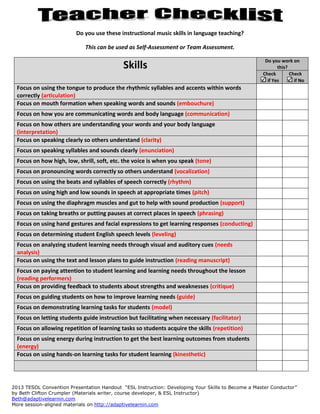
TESOL 2013 Handouts Checklist (Do you do these in the language classroom?): ESL Instruction: Developing Your Skills to Become a Master Conductor
- 1. Do you use these instructional music skills in language teaching? This can be used as Self-Assessment or Team Assessment. Do you work on Skills this? Check Check if Yes if No Focus on using the tongue to produce the rhythmic syllables and accents within words correctly (articulation) Focus on mouth formation when speaking words and sounds (embouchure) Focus on how you are communicating words and body language (communication) Focus on how others are understanding your words and your body language (interpretation) Focus on speaking clearly so others understand (clarity) Focus on speaking syllables and sounds clearly (enunciation) Focus on how high, low, shrill, soft, etc. the voice is when you speak (tone) Focus on pronouncing words correctly so others understand (vocalization) Focus on using the beats and syllables of speech correctly (rhythm) Focus on using high and low sounds in speech at appropriate times (pitch) Focus on using the diaphragm muscles and gut to help with sound production (support) Focus on taking breaths or putting pauses at correct places in speech (phrasing) Focus on using hand gestures and facial expressions to get learning responses (conducting) Focus on determining student English speech levels (leveling) Focus on analyzing student learning needs through visual and auditory cues (needs analysis) Focus on using the text and lesson plans to guide instruction (reading manuscript) Focus on paying attention to student learning and learning needs throughout the lesson (reading performers) Focus on providing feedback to students about strengths and weaknesses (critique) Focus on guiding students on how to improve learning needs (guide) Focus on demonstrating learning tasks for students (model) Focus on letting students guide instruction but facilitating when necessary (facilitator) Focus on allowing repetition of learning tasks so students acquire the skills (repetition) Focus on using energy during instruction to get the best learning outcomes from students (energy) Focus on using hands-on learning tasks for student learning (kinesthetic) 2013 TESOL Convention Presentation Handout “ESL Instruction: Developing Your Skills to Become a Master Conductor” by Beth Clifton Crumpler (Materials writer, course developer, & ESL Instructor) Beth@adaptivelearnin.com More session-aligned materials on http://adaptivelearnin.com
- 2. Do we use these skills in our classroom? This is a survey for individual students or groups to give feedback to the instructor. Do we work on Skills this? Check Check if if Yes No Focus on using the tongue to produce the rhythmic syllables and accents within words correctly (articulation) Focus on mouth formation when speaking words and sounds (embouchure) Focus on how you are communicating words and body language (communication) Focus on how others are understanding your words and your body language (interpretation) Focus on speaking clearly so others understand (clarity) Focus on speaking syllables and sounds clearly (enunciation) Focus on how high, low, shrill, soft, etc. the voice is when you speak (tone) Focus on pronouncing words correctly so others understand (vocalization) Focus on using the beats and syllables of speech correctly (rhythm) Focus on using high and low sounds in speech at appropriate times (pitch) Focus on using the diaphragm muscles and gut to help with sound production (support) Focus on taking breaths or putting pauses at correct places in speech (phrasing) Focus on using hand gestures and facial expressions to get learning responses (conducting) Focus on determining student English speech levels (leveling) Focus on analyzing student learning needs through visual and auditory cues (needs analysis) Focus on using the text and lesson plans to guide instruction (reading manuscript) Focus on paying attention to student learning and learning needs throughout the lesson (reading performers) Focus on providing feedback to students about strengths and weaknesses (critique) Focus on guiding students on how to improve learning needs (guide) Focus on demonstrating learning tasks for students (model) Focus on letting students guide instruction but facilitating when necessary (facilitator) Focus on allowing repetition of learning tasks so students acquire the skills (repetition) Focus on using energy during instruction to get the best learning outcomes from students (energy) Focus on using hands-on learning tasks for student learning (kinesthetic) 2013 TESOL Convention Presentation Handout “ESL Instruction: Developing Your Skills to Become a Master Conductor” by Beth Clifton Crumpler (Materials writer, course developer, & ESL Instructor) Beth@adaptivelearnin.com More session-aligned materials on http://adaptivelearnin.com
